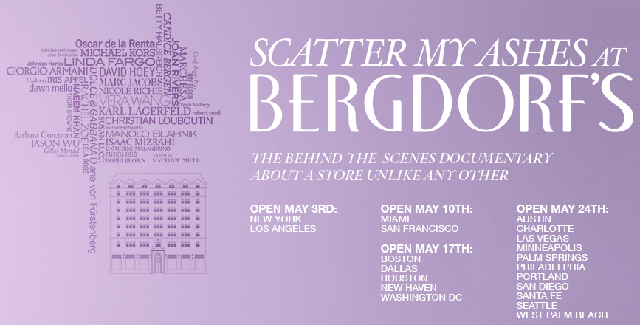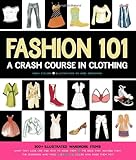Scatter My Ashes makes Bergdorf Goodman accessible

‘Scatter my Ashes at Bergdorf’s’ makes the Manhattan super store accessible through behind-the-scenes interviews with sales staff, designers and family. Did you know Yoko Ono spent $400,000 of John Lennon’s money on furs for Christmas Eve?
I recently started obsessing over clothes and fashion to a level I can’t explain. While I haven’t hit the arena where it affects my pocketbook, as a former frequenter of Old Navy, Gap Outlet and TJMaxx, I don’t understand why my style shifted from faded denim overalls to quirky business professional. Maybe it’s the conundrum that occurs when you pass your twenties and grow more interested in presenting yourself for yourself as opposed to your date. But, after chronicling my ongoing love affair with Breakfast at Tiffany’s, searching for the best Birkin bag not-knock-off and uncovering the perfect Little Black Dress, of course, I had to cover Scatter My Ashes at Bergdorf’s.
Scatter My Ashes at Bergdorf’s is a documentary about the iconic New York department store’s relationship with its fashion designers as well as a behind the scenes look at key staff that interact with the public through sales and window dressing. For the screening, in honor of Bergdorf, I threw on my very best Melie Bianco from Target, dusted off my best priced-down Banana Republic, and shook out my favorite almost-Noelani Jelly flats.
The film’s overall theme surrounded subverting yet simultaneously emphasizing our surface understanding of Bergdorf Goodman. While documentarian Matthew Miele played to contemporary perceptions of Bergdorf as the magical supplier of luxury fashion through interviews of fashion designers such as Jason Wu as well as key clients like Nicole Richie, he also portrayed the lives of core staff members. By opening the film with a stark, silent shot of a Bergdorf doorman before his working middle-class home, drinking coffee, Miele visually implies this film will sit outside the audience’s comprehension of Bergdorf’s as for the elite 1%. Previously, I never considered the people who purchased the clothes, sold the clothes or designed the showcases for the clothes. I always assumed it happened magically while the staff who coordinated it handled organization apathetically. However, the establishing shot following the doorman’s early morning public commute intimated Bergdorf isn’t just for the wealthy, it’s for everyone, including those who served the wealthy. By displaying the time and effort of the sales staff surrounding picking items as well as the incredible delight and artistic vision of the window dressing staff, Miele repeatedly intimates BG is a magical place for everyone.
Rather than construct the documentary as a candy-coated homage to Bergdorf, he asked tough questions and incorporated humor. Occasionally Miele asked his on-camera subjects about their salaries, further subverting our understanding of the finances of the upper class customer served by the middle-class staff. According to glassdoor, BG sales people make around $15-34/hour, which could tally up to $100,000. However, Miele implied salespeople could make up to $400,000 on commission. Additionally, he didn’t stray away from mocking his on-camera subjects or BG itself. Five seconds after the head window designer derisively wonders what idiot would study window dressing, Miele flips to a writer detailing her days analyzing window designs.
Miele further inverted my understanding of Bergdorf as a distant upper-class enclave, by revealing the approach of Linda Fargo, the Women’s Fashion Director, to new designers. Even if a designer isn’t ready, she and her staff remain in contact with the person and urge folded-in designers to use the best quality fabrics alongside an awareness of their market. While watching Fashion Star this season, I felt disappointed when the designs translated from the runway to the department store, shifted from calf to knee length or used a lesser quality material. It’s nice seeing a store encourage designers to stay true to their original goals.
Despite maintaining unobtrusive camera work, Miele added a cinematic polish to the documentary through the transitions and a slick, stylized city metamorphosis shot accompanying the doorman’s commute before shifting to standard documentary. I loved the interspersed black and white shots featuring moving female shadows as well as the underlying Barbara Streisand motif. However, above all, the true star proved to be the music.
Admittedly, not all of the film flowed as smooth as BG’s products. My main complaint surrounded organization. I liked the implicit structure of fashion’s importance, Bergdorf’s history, Bergdorf’s current design importance, fashion store politics and a nod to BG workers. However, Miele covertly upended that structure by cycling back to Bergdorf history or fashion designer interviews after interviewing internal staff. Some background stories I feel he ended too soon. I loved the tidbits about Halston; but, after so many interviews emphasized how Bergdorf made fashion careers, I would’ve loved to see the converse — how Halston’s BG break negatively impacted his career. After interviewing celebrity shopper Betty Halbreich, a contrast of candid interviews with lower ranked staff would’ve worked well. Finally, we didn’t need the Alexander McQueen Met show to ground us in the importance of fashion, considering he didn’t tie it back to the store’s past\current Alexander McQueen collection or to the store’s own Savage Beauty window display.
Additionally, while Miele demonstrated Bergdorf’s international reach through its designers, he couldn’t fully exemplify racial diversity amongst the store’s staff or clientele. One shot of a male African-American performer across the street in the beginning, another shot of an African-American woman at an after-hours event and a brief conversation with an African-American shoe salesman, out of a 90-minute documentary, didn’t quite do it. However, rather than overtly acknowledge what his camera crowd shots displayed — a majority Caucasian clientele — Miele pussyfoots around it with mild diversity nods.
In the end, what made Bergdorf accessible to me weren’t the staff interviews or interviews with the formerly struggling designers who joined the 1% with Bergdorf’s assistance. The documentary made the store accessible through interior shots showing the store as equal to any mall or department store selling clothes. That’s when I realized that despite the talk of clothes making the person, that’s all they truly are — clothes.
So, do I want to scatter my ashes (or my salary) at Bergdorf? While I’m not going to spend the equivalent of a house down-payment on a shoe, I might go for lunch, get tipsy and consider splurging on a $200 Alice-Olivia shoe.
Scatter My Ashes at Bergdorf’s currently shows in select theatres. For additional information on area release dates check out BG’s page for the Documentary or the Documentary’s Facebook page.
 CliqueClack
CliqueClack










